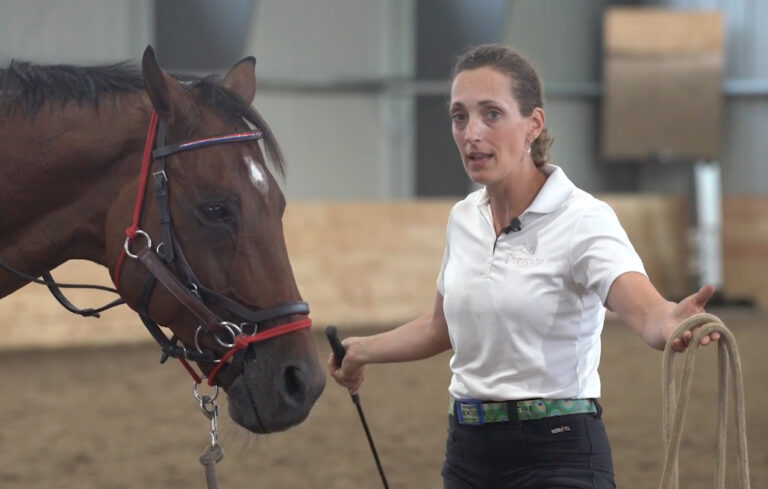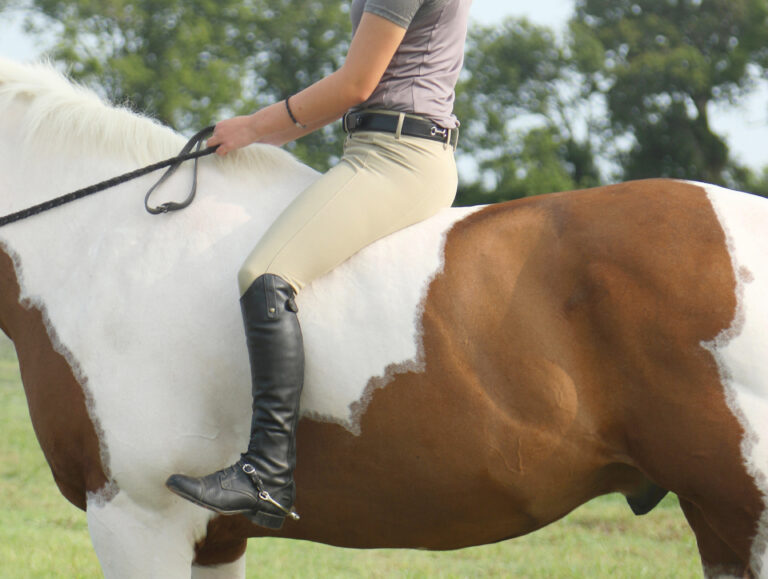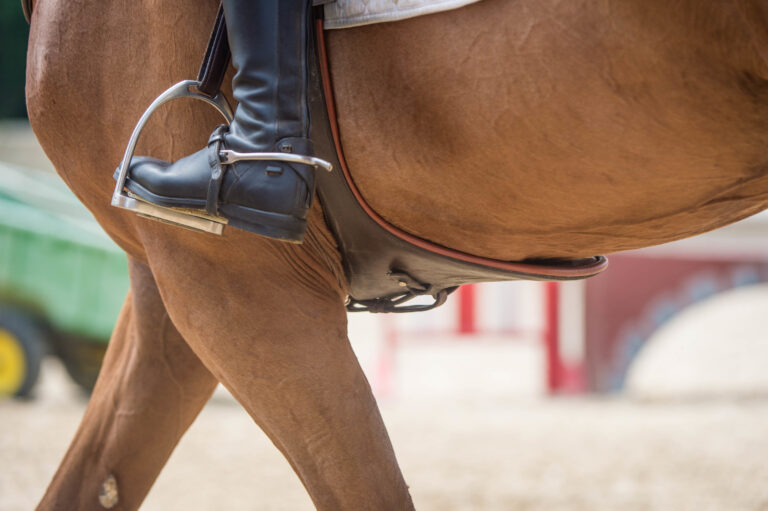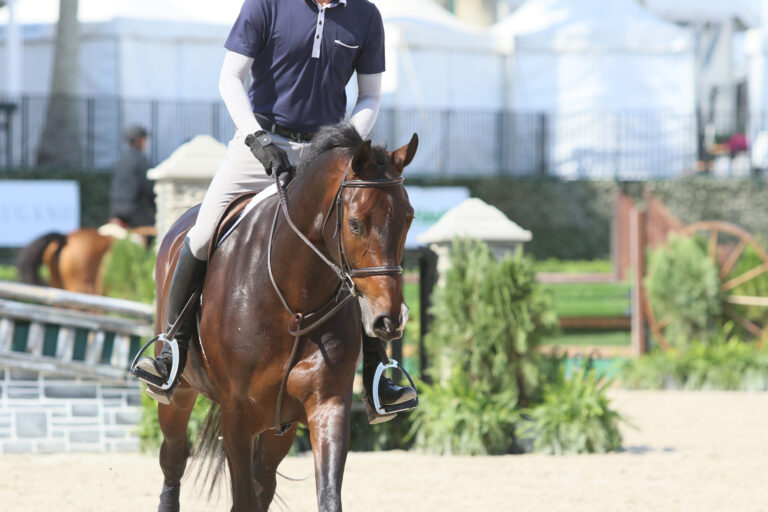The terms “rhythm” and “tempo” describe two totally different things, yet they’re commonly confused. In dressage, it’s very important to understand how they differ, learn how to evaluate your own horse’s rhythm and tempo and correct them when necessary.
Rhythm describes the footfalls, or beats, of a gait. The walk is four beats, the trot is two, canter is three and gallop is four. The rein back is also a two-beat gait: It’s just trotting backward, but more slowly and without the moment of suspension between beats. Whenever a horse’s gait does not clearly have the correct number of beats, it’s considered impure and is heavily penalized. Rhythm is one of the primary factors that judges consider when scoring the regularity of the gaits in the collective marks.
Tempo is basically the speed of a gait’s beats—how slowly or quickly the hooves are striking the ground. Ideally, your horse should maintain the same tempo throughout each movement of a test, without speeding up or slowing down significantly. His tempo may change slightly from movement to movement. For example, an extended trot usually has a quicker tempo than a collected trot. However, with really talented, well-trained horses, the tempo variation between collected trot, passage, piaffe and extended trot is minimal.
As your dressage education progresses, you will hear other terms, such as cadence and suspension, which further define the quality of the gaits. These will make more sense to you once you’ve thoroughly familiarized yourself with the fundamental concepts of rhythm and tempo. I’ll help you do that in this two-part series, focusing on rhythm in this article and tempo in the Winter 2019 issue.
Rhythm: Feel the Beat
Rhythm is largely determined by a horse’s natural gaits. Some horses are born with very clear rhythm, while others possess a tendency to lose that clarity from time to time. Riders can influence such tendencies significantly, for better or worse.
To check that your horse’s rhythm is correct in each gait, simply count the beats out loud. At the walk, the count should be “one-two-three-four, one-two-three-four.” The trot should be “one-two, one-two,” and the canter should be “one-two-three, one-two-three.”
If your horse doesn’t have a clear two-beat trot, he’s either lame or is a gaited horse falling into a less common gait, like a running walk or rack, for which gaited horses are specifically bred. For most horses, the two danger zones in which rhythm issues can arise are the walk and canter. The most common walk rhythm problem is a “lateral walk,” or pace, in which the legs tend to move in lateral pairs, with the right fore and hind leg together and the left fore and hind leg together. This produces more of a two-beat rhythm than the correct four beats.
The most common canter rhythm problem we see in dressage horses is a four-beat canter. This happens when the timing of the diagonal pair of legs that normally strike the ground simultaneously slightly separates, creating two beats instead of one. This can happen when you slow the canter down too much without creating adequate impulsion in the hind end to sustain that slower canter.
Having a clear idea of the correct beats for each gait will help you identify any rhythm problems your horse might have. I find the lateral walk and four-beat canter incredibly uncomfortable. However, some pleasure riders have no problem with the four-beat canter, which they often create by slowing the canter down dramatically. If you have any doubts about the clarity of your horse’s rhythm, take a lesson with a trainer you trust and ask her to watch his gaits closely.
Another great tool is video. Ask a friend to video you while you ride, then watch the video carefully. How your ride feels may not always correlate with how it looks. Again, if you have any questions, consult a professional. Even we professionals go to other professionals to keep us in line and to make sure what we’re feeling is looking right, too.
Some rhythm problems can actually be aggravated, rather than resolved, by dressage training—if it’s done wrong. As you go up the levels, the movements come quicker and have a harder degree of difficulty. To perform the more advanced movements correctly, horses have to become much suppler and more equally balanced on both sides. Otherwise, that tension and imbalance disrupt the rhythm. Say you see a bit of a discrepancy in your horse’s leg-yield at First Level—it’s much easier for him to go sideways in one direction than the other way. If you don’t address the imbalance at that stage, it will become amplified even more when you get to Second Level and all of a sudden have to do haunches-in and shoulder-in, 8-meter trot circles and counter-canter serpentine loops.
To avoid rhythm issues, be aware of what your horse is doing beneath you and know where his defaults are. His hind end should always be underneath him, carrying his body weight equally on both hind legs. He should never “cheat” by stepping the outside hind leg to the outside of the track he’s following around corners or during lateral work. You must evaluate each horse individually and say, “OK, what is he doing and how can I help him with that?” For example, if your horse constantly pushes against your right leg, steps to the outside with the right hind leg and fishtails around left turns, you need to be vigilant about asking him to step over to the left instead.
Here are some specific tools to help prevent and correct rhythm problems:
Fix the Walk Rhythm
The walk rhythm is particularly vulnerable to being unintentionally disrupted by incorrect training, tension or a poorly-fitted saddle. Repairing an irregular walk can require a great deal of feel and experience. So don’t be afraid to ask a professional for help if you need it.
Although some horses have more of a natural tendency to walk laterally than others, tension in the back and/or neck is often a large contributor. The first thing I check for is tension in the rider’s hip and thigh, which can easily transfer to the horse and kill the gait immediately. To be sure that you’re not tipped forward onto your crotch with a locked hip and tight thigh, practice this exercise:
Exercise 1: Leg Loosener
Try this first at a standstill: Keeping just enough pressure on your stirrup to prevent it from slipping off, lift one knee away from the saddle so there are a few inches of space between your entire leg and your horse’s side. Then allow your leg to gently drop back into place in such a way that you feel more weight on the back of your thigh than on the front. Also check that your seat is positioned slightly behind your knee, not directly on top of it. Your hip should be vertically aligned with your heel. Sit on your tailbone in a relaxed way, feeling contact between your inner thigh and the saddle, but never gripping. Repeat the same exercise with the other leg.
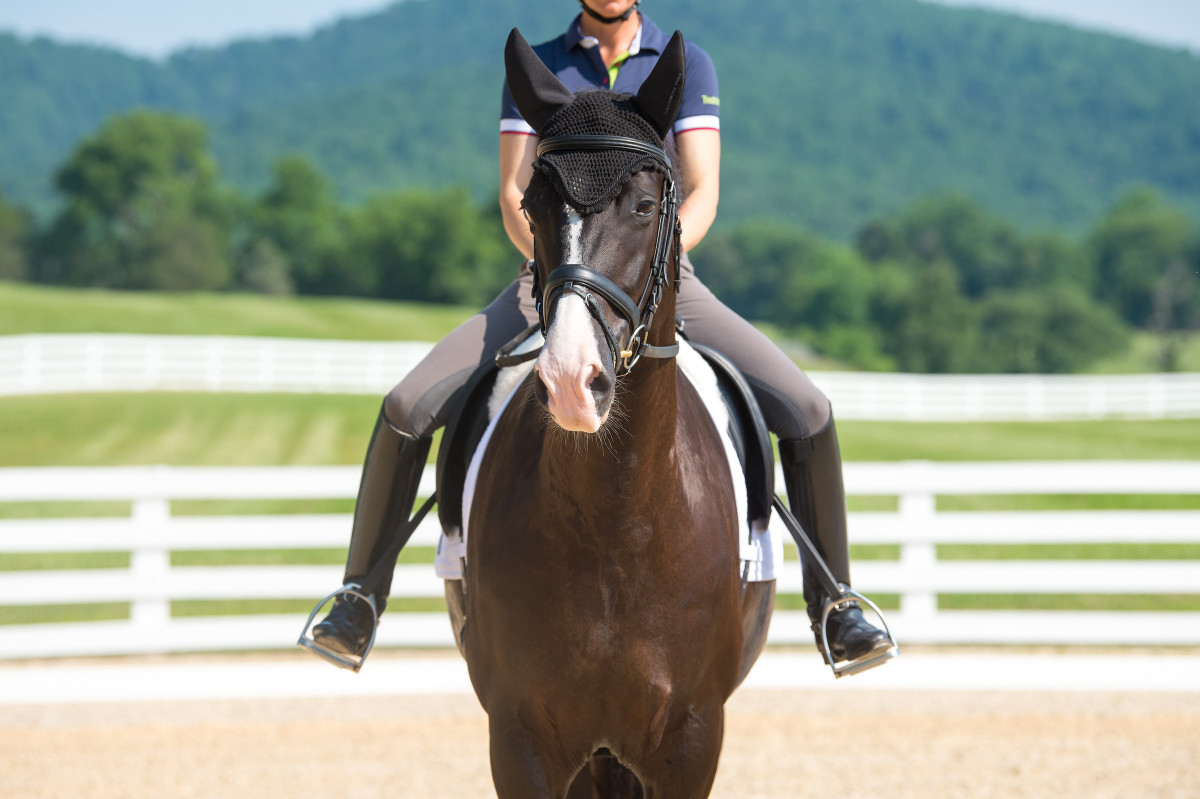
Amy K. Dragoo/AIMMEDIA
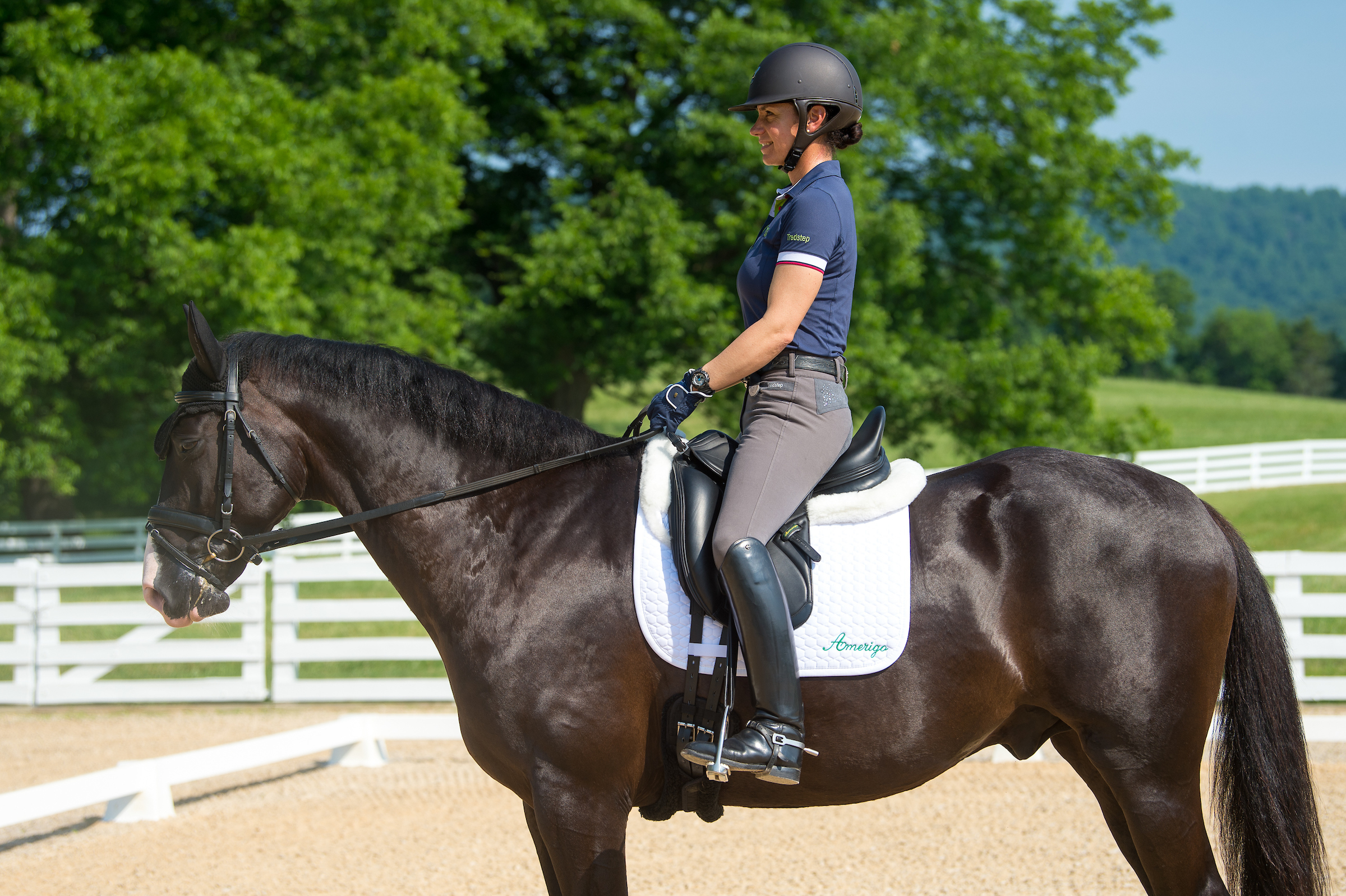
Amy K. Dragoo/AIMMEDIA
When this feels comfortable, try lifting both legs off the saddle at the same time, momentarily balancing on only your seat bones. Depending on how good your balance is, you can also try this exercise—either one leg at a time or both simultaneously—at the walk, trot and canter. Just be sure to never pull back on the reins to maintain your balance. You can hook a finger around the pommel or a bucking strap to help you balance.
Staying loose and relaxed in your seat with your hips following forward every step is critical for allowing your horse to feel comfortable moving through himself. Especially at the walk, if you are remotely tight in your seat, you risk making him tighten his back—and ruining the gait. Never default to pushing or driving with your seat in the walk, even on a horse who’s not going forward. Always ask him to speed up from your leg instead.
Holding too much rein contact in a backwards connection—pulling toward your body instead of receiving a forward connection toward your horse’s mouth—is another way to disturb the walk rhythm. This can bring the horse’s neck and head carriage too high, preventing him from stretching into the bridle. It causes the neck to tighten and the back to drop, which can also result in a lateral walk.
Exercise 2: Shoulder-in or Shoulder-fore at the Walk
Once you’ve ruled out any possible position or aid sources of the walk–rhythm problem, try using the shoulder-in or shoulder-fore (a milder version of the shoulder-in) to address it. Using your inside leg at the girth to create a good inside bend, turn your upper body to the inside and take both hands toward the inside to ask your horse to bring his shoulders slightly in off the track. Meanwhile, keep your outside leg against his side behind the girth, controlling the outside hind leg from stepping to the outside. All the while, be sure that you’re never creating tension in the neck by using too much rein contact. (To read more about shoulder-in, see “Where Real Dressage Begins: Shoulder-In” with Lauren Sprieser in the Summer 2019 issue.)
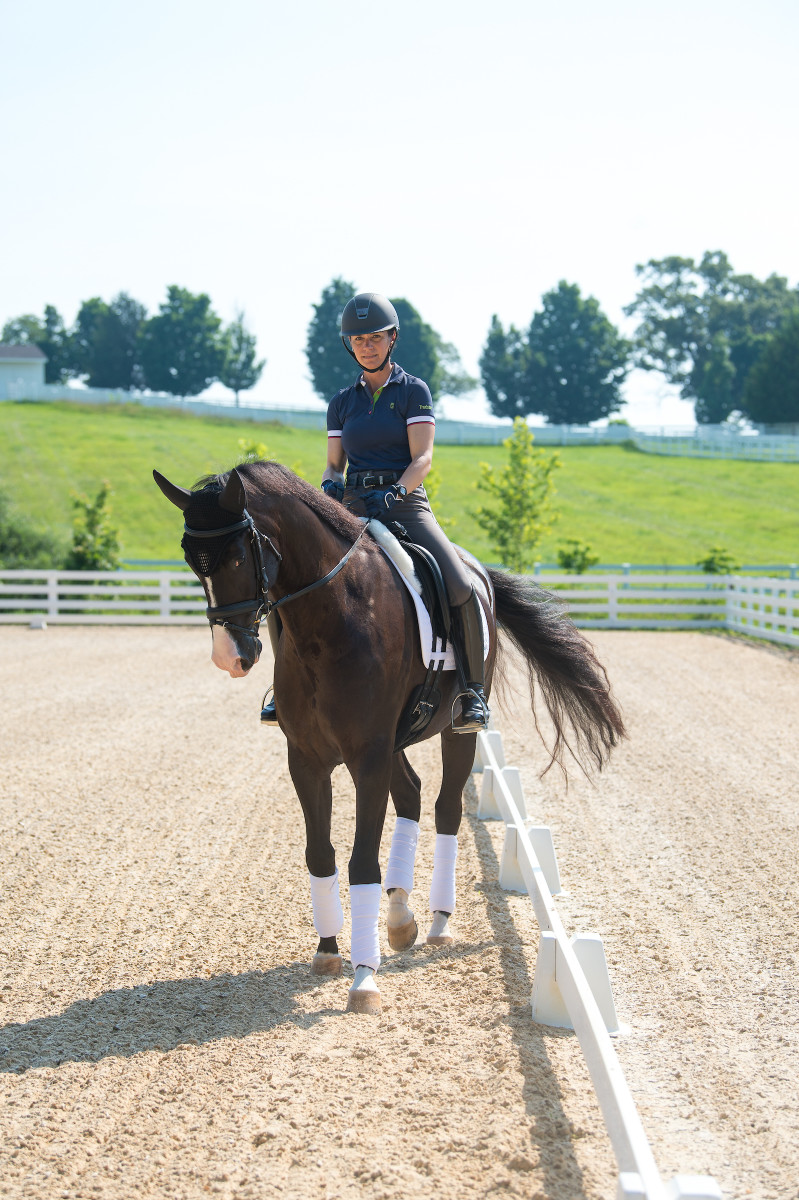
Amy K. Dragoo/AIMMEDIA
Creating this added bend will encourage your horse to stay supple through his body and use his hind legs properly, thus preventing him from falling into a two-beat gait. If you have a horse with a lateral-walk tendency, you can even ride all the walk work in your tests in a slight shoulder-fore. The judge won’t be able to see it, but it’ll provide just enough bend to keep the walk rhythm pure.
Fix the Canter Rhythm
To me, the four-beat canter always stems from a weakness in the outside hind leg. That leg takes the first push-off step for every stride. Whenever it’s not underneath the horse’s body—for example, if his hind end swings to the outside on a turn, forcing the inside leg to carry more of his weight while the outside leg does less work—it’s very easy for the gait to become four-beat and disconnected. So I’m always asking, “Is the outside hind leg involved enough? Is it pushing off the ground quickly enough?” If the answer is no, here are two helpful exercises for solving the problem:
Exercise 3: Control the Hind Legs Through The Corner
In dressage, we talk a lot about bending the horse to the inside through corners and other figures by pushing him from your inside leg to your outside rein. This can backfire if your horse tends to swing his haunches to the outside in one direction and you fail to control that with your outside leg. To counteract this habit effectively, you need to evaluate his strengths and weaknesses and be conscious of them through every turn and figure.
So, for example, if you have a horse with a weak left hind leg, when you’re trotting to the left he’ll try to step to the inside with his hips. Trotting to the right, he’ll try to swing his haunches to the outside. To correct this, use more left leg to keep his haunches tracking properly behind his shoulders in both directions.
Exercise 4: Shoulder-in to Haunches-in to Shoulder-in
One of the best ways to fix a rhythm problem is by increasing your horse’s suppleness with lateral work. If you’re familiar with shoulder-in and haunches-in, use those frequently to address his imbalance. For the previous example—the horse with a weak left hind leg—practice lots of shoulder-in to the left and haunches-in to the right, both in trot and canter. This will help to keep that left hind under his body at all times.
Be careful, however, when doing lateral work. One mistake I see a lot of riders make when attempting a shoulder-fore is using the inside leg aid to push the horse’s hind leg to the outside, instead of using the reins and combined bending aids to bring the forehand in. This creates the exact problem that leads to rhythm faults like a four-beat canter!
One canter exercise I like to do frequently is transitioning from shoulder-in or shoulder-fore immediately into haunches-in, then back to shoulder-in or shoulder-fore, and then back to haunches-in. This way, I can make sure I have the bend initially with my horse’s forehand to the inside, but then I put the forehand back on the track and ask him to yield behind me, putting that outside hind leg directly under his center of gravity and making it really fire and be supple. That’s a good checkpoint for ensuring the canter is correct and pure.
USDF Definitions
Terms like rhythm, tempo, regularity, cadence and suspension come up frequently in dressage tests. Here’s how the U.S. Dressage Federation defines them:
Rhythm: The recurring characteristic sequence and timing of footfalls and phases of a gait. For purposes of dressage, the only correct rhythms are those of the pure walk, trot, canter, rein back and piaffe.
Tempo: The rate of repetition of the strides as may be measured by a metronome. Tempo is measured by counting the number of times per minute that one of the hooves touches down (indicating completion of one full stride). Alternatively, at walk and trot, both emphasized beats of the stride may be counted.
Regularity: The purity of the gait. At walk and trot, denotes symmetry in terms of evenness of the length of the steps, levelness of the height of the steps, and equality of the time interval between the steps of the left and right forelimbs or the left and right hind limbs.
Note: In the first collective mark on a dressage test, “Gaits (freedom and regularity),” regularity is used to address purity and soundness, not to address the horse’s tempo.
Cadence: The marked accentuation of the rhythm and emphasized beat that is a result of a steady and suitable tempo harmonizing with a springy impulsion.
Suspension: The moment or phase of the trot, canter or passage in which the horse has no feet on the ground.
About Ali Brock

Allison (Ali) Brock grew up in Hawaii, where she was very active in Pony Club, jumped, rode dressage, exercised polo ponies and rode Western. After high school, she moved to the mainland to work with several well-known dressage trainers, including Olympian Sue Blinks. When Sue moved to the West Coast in 2004, Ali took over the head trainer position at Fritz and Claudine Kundrun’s DeerMeadow Farm in Keswick, Virginia. She developed the Kundruns’ now-retired Hanoverian stallion Rosevelt from a 6-year-old to a team bronze medalist at the 2016 Rio Olympics. While bringing along her next stars, she continues to be an active clinician and official ambassador for Brooke USA, a nonprofit organization dedicated to improving the welfare of working horses, mules and donkeys around the world.
This article originally appeared in the Fall 2019 issue of Practical Horseman.





